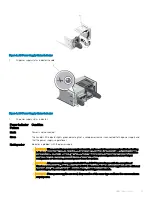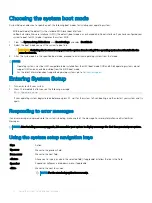
The
System Profile Settings
screen details are explained as follows:
Option
Description
System Profile
Sets the system profile. If you set the
System Profile
option to a mode other than
Custom
, the BIOS automatically
sets the rest of the options. You can only change the rest of the options if the mode is set to
Custom
. This option
is set to
Performance Per Watt Optimized (DAPC)
by default. DAPC is Dell Active Power Controller.
NOTE:
All the parameters on the system profile setting screen available only when the System Profile
option is set to Custom.
CPU Power
Management
Sets the CPU power management. This option is set to
System DBPM (DAPC)
by default. DBPM is Demand-
Based Power Management.
Memory Frequency
Sets the speed of the system memory. You can select
Maximum Performance
,
Maximum Reliability
, or a specific
speed.
Turbo Boost
Enables or disables the processor to operate in turbo boost mode. This option is set to
Enabled
by default.
C States
Enables or disables the processor to operate in all available power states. This option is set to
Enabled
by default.
Monitor/Mwait
Enables the Monitor/Mwait instructions in the processor. This option is set to
Enabled
for all system profiles,
except
Custom
by default.
NOTE:
This option can be disabled only if the C States option in the Custom mode is set to disabled.
NOTE:
When C States is set to Enabled in the Custom mode, changing the Monitor/Mwait setting does
not impact the system power or performance.
Memory Patrol
Scrub
Sets the memory patrol scrub frequency. This option is set to
Standard
by default.
Memory Refresh
Rate
Sets the memory refresh rate to either 1x or 2x. This option is set to
1x
by default.
Memory Operating
Voltage
Sets the DIMM voltage selection. When set to Auto, the system automatically sets the system voltage to the
optimal setting based on the DIMM capacity and the number of DIMMs installed. By default, the Memory
Operating Voltage option is set to Auto.
Collaborative CPU
Performance
Control
Enables or disables the CPU power management. When set to
Enabled
, the CPU power management is controlled
by the OS DBPM and the System DBPM (DAPC). This option is set to
Disabled
by default.
System security screen
Menu Item
Description
Intel AES-NI
Improves the speed of applications by performing encryption and decryption using the Advanced Encryption
Standard Instruction Set and is set to
Enabled
by default.
System Password
Allows you to set the system password. This option is set to
Enabled
by default and is read-only if the password
jumper is not installed in the system.
Setup Password
Allows you to set the setup password. This option is read-only if the password jumper is not installed in the system.
Password Status
Allows you to lock the system password. By default, the
Password Status
option is set to
Unlocked
.
TPM Security
Allows you to control the reporting mode of the Trusted Platform Module (TPM). By default, the
TPM Security
option is set to
Off
. You can only modify the TPM Status, TPM Activation , and Intel TXT fields if the
TPM Status
field is set to either
On with Pre-boot Measurements
or
On without Pre-boot Measurements
.
Using the system setup and boot manager
27
















































